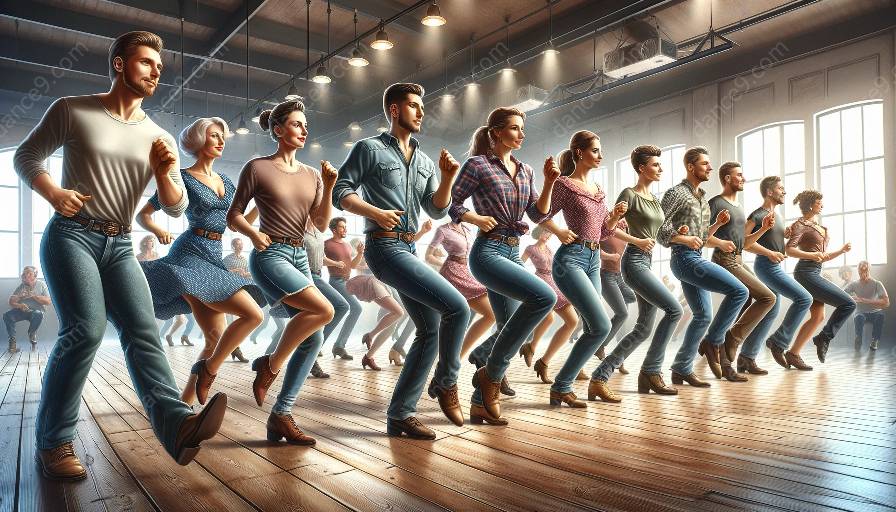Line dancing is a popular form of dance where a group of people dance in rows or lines, facing the same direction and executing the same steps at the same time. It's a fun and energetic activity that is enjoyed by people of all ages and skill levels. In this comprehensive guide, we will explore the fundamentals of line dancing, including its history, basic steps, music, and how to get started with line dance classes.
The History of Line Dancing
Line dancing has a rich and diverse history that spans different cultures and traditions. It has its roots in folk dances from various regions around the world, including Europe, the United States, and other parts of the globe. These traditional dances were often performed in lines or circles, with dancers executing synchronized steps to the beat of the music.
Over time, line dancing evolved and gained popularity in different social settings, such as community gatherings, social events, and entertainment venues. In the 1970s and 1980s, line dancing experienced a surge in popularity, thanks to country music and western dance culture. The dance form became a staple in country music dance halls, where people would gather to dance to their favorite country tunes.
Today, line dancing has transcended its country music origins and is enjoyed across a wide range of music genres, including pop, rock, and R&B. It has become a global phenomenon, with enthusiasts participating in line dance classes and social events worldwide.
Basic Steps and Techniques
One of the key aspects of line dancing is its simplicity and accessibility. The basic steps and techniques of line dancing are easy to learn, making it a great entry point for beginners. The dances are choreographed with a sequence of steps that repeat throughout the music, allowing dancers to follow along and enjoy the experience without the need for a partner.
Common line dance steps include variations of the grapevine, shuffle, step touch, and pivot turn, among others. These steps are often combined in different formations, creating a diverse range of line dances with varying levels of complexity. Instructors and choreographers often design line dances that cater to different skill levels, ensuring that there is something for everyone to enjoy.
Learning the fundamental steps and techniques of line dancing is a rewarding experience that fosters a sense of camaraderie and accomplishment. As dancers progress and become more proficient, they can explore more intricate and challenging dances, further expanding their repertoire and skill set.
The Role of Music in Line Dancing
Music plays a central role in line dancing, providing the rhythm and energy that drives the dancers. The choice of music influences the style and choreography of line dances, with different genres and tempos inspiring unique dance movements and expressions.
Line dances are often performed to popular songs with catchy beats and distinct rhythms. From country hits to classic rock anthems and modern pop tracks, the diversity of music that accompanies line dancing adds to the overall appeal and enjoyment of the dance form.
In line dance classes, instructors carefully select music that resonates with the participants, creating an engaging and dynamic environment for learning and dancing. As dancers become familiar with different types of music, they develop a deeper appreciation for various genres and styles, enhancing their overall dance experience.
Getting Started with Line Dance Classes
For individuals interested in exploring line dancing further, attending line dance classes is an excellent way to learn the fundamentals and connect with fellow enthusiasts. Line dance classes are offered by dance studios, community centers, fitness clubs, and social organizations, providing convenient options for people to get involved.
Whether you're a complete beginner or have some prior dance experience, line dance classes cater to all skill levels. In a typical class, participants learn a variety of line dances, receive step-by-step instructions, and practice the dances in a supportive and encouraging environment. The classes are an opportunity to improve coordination, balance, and overall fitness while enjoying the social aspect of dancing with others.
In addition to the physical benefits, line dance classes offer a sense of community and camaraderie, creating a welcoming space for people to come together, have fun, and express themselves through dance. It's a place where individuals can celebrate the joy of movement and music, fostering lasting friendships and shared experiences.
Conclusion
Line dancing is more than just a dance form; it's a celebration of culture, music, and togetherness. By understanding the fundamentals of line dancing, including its history, basic steps, music, and the opportunities to join line dance classes, you can embark on a fulfilling journey of exploration and enjoyment. Whether you're looking to embrace a new hobby, stay active, or simply have a great time, line dancing offers a world of possibilities for everyone to discover.













































































